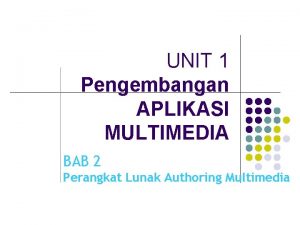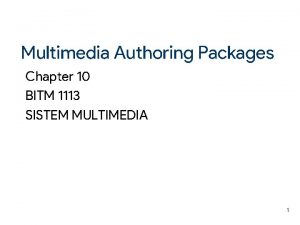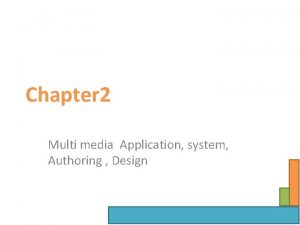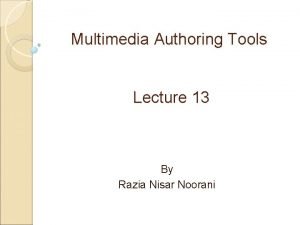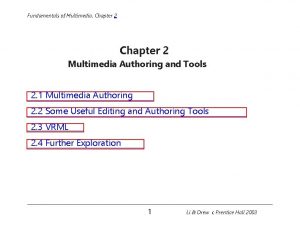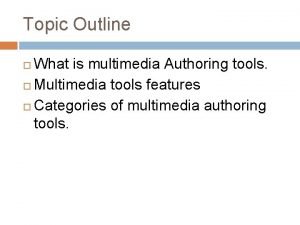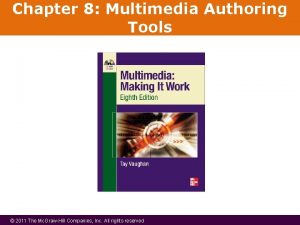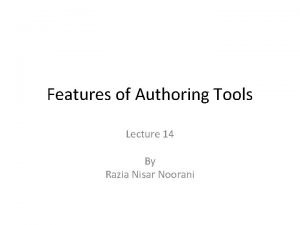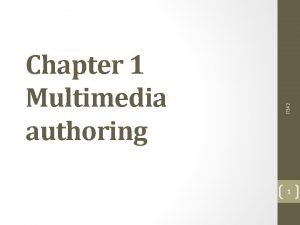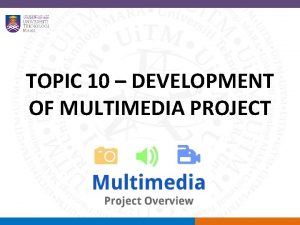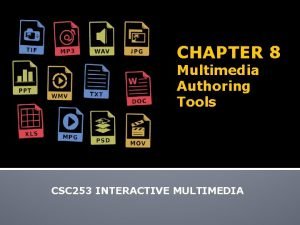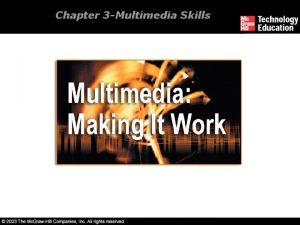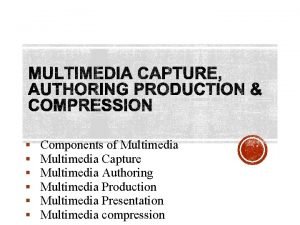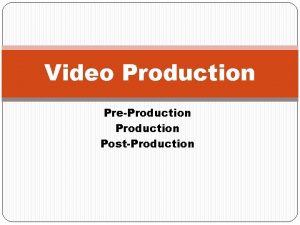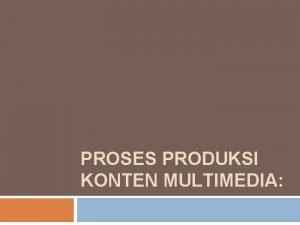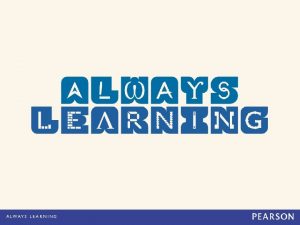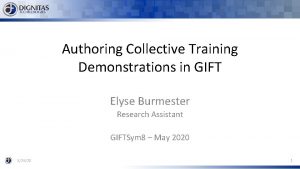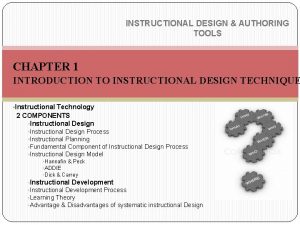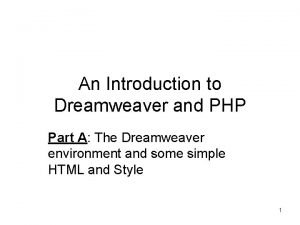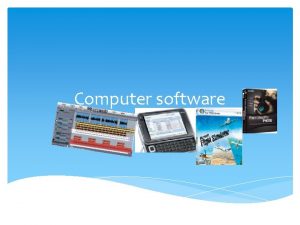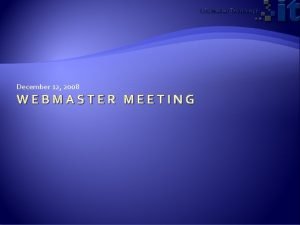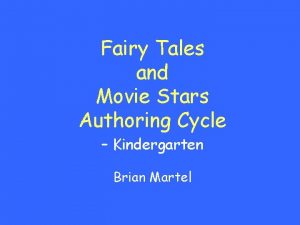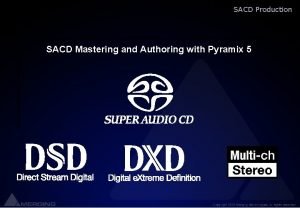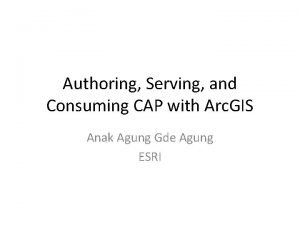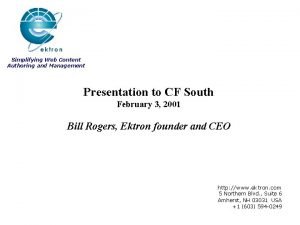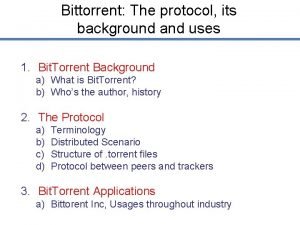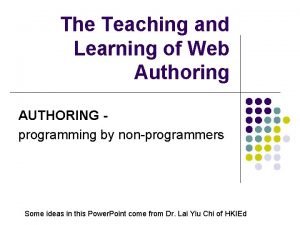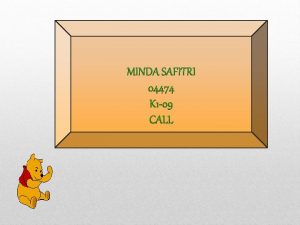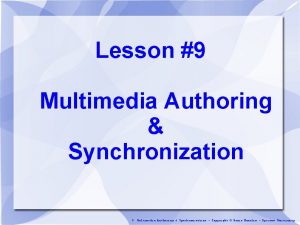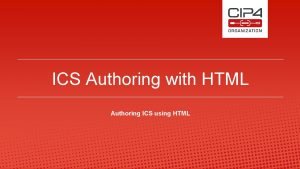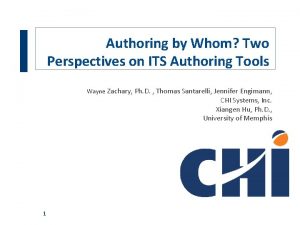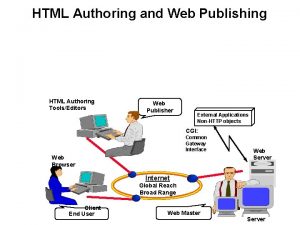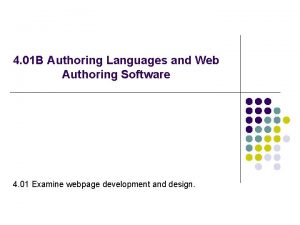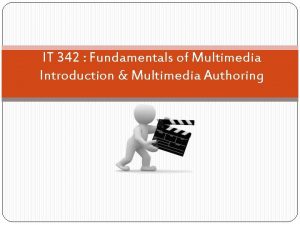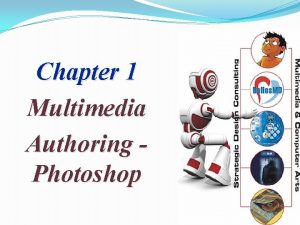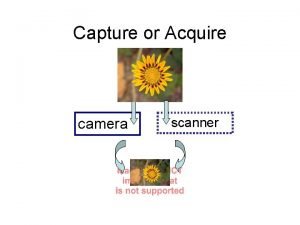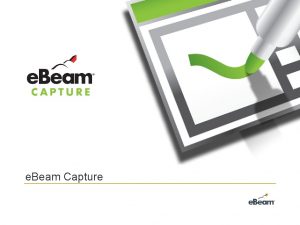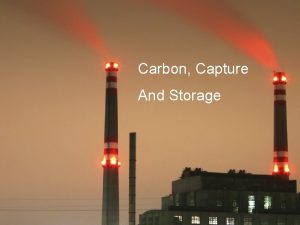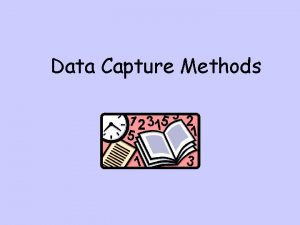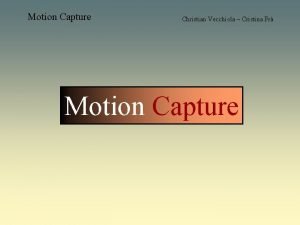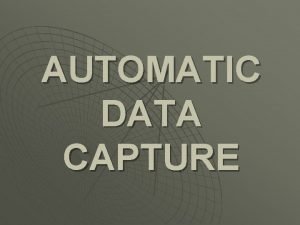Components of Multimedia Capture Multimedia Authoring Multimedia Production































- Slides: 31

§ § § Components of Multimedia Capture Multimedia Authoring Multimedia Production Multimedia Presentation Multimedia compression

§ Multimedia items generally fall into one of five main categories and use varied techniques for digital formatting. Text § Text in multimedia systems can express specific information, or it can act as reinforcement for information contained in other media items. Eg. Web pages may include image elements and a short amount of text as an alternative, in case the digital image item is not available. § Source: keyboard, speech input, optical character recognition, data stored on disk. § Stored as 1 byte per char § Format: Raw text or formatted text e. g HTML, Rich Text Format (RTF),

Graphics § Is a digital representation of information such as a drawing, a chart, or a photograph. § First media used to enhance the originally text-based Internet. § Format: Common graphical formats on the Web are JPEG and GIF. § Other graphical formats such as BMP and TIFF have larger file sizes, and may require special viewer software to display on the Web. § To reduce download times for graphics, some Web sites use thumbnails, which is a smaller version of a larger graphical image that a user may click to display the full sized image.

Graphics… § Input: Graphics are usually generated by a graphics editor program (e. g. Illustrator) or automatically by a program (e. g. Postscript). § Graphics are usually editable or revisable (unlike Images). § Graphics files usually store the primitive assembly and do not take up a very high storage overhead.

Images § Still pictures which (uncompressed) are represented as a bitmap (a grid of pixels). § Input: digitally scanned photographs/pictures or direct from a digital camera. May also be generated by programs similar" to graphics or animation programs. § Stored at 1 bit per pixel (Black and White), 8 Bits per pixel (Grey Scale, Colour Map) or 24 Bits per pixel (True Colour) § Size: a 512 x 512 Grey scale image takes up 1/4 MB, a 512 x 512 24 bit image takes 3/4 MB with no compression. § This overhead soon increases with image size. Compression is commonly applied.

Audio § Can be music, speech, or any other sound. § Common audio formats include WAV, MID, and MP 3. § Audio signals are continuous analog signals. § Some Web sites use streaming audio, which allows a user to listen to the sound as it downloads to the computer. Two accepted standards for streaming audio on the Web are Windows Media Player and Real. Audio. § Input: microphones and then digitised and stored § CD Quality Audio requires 16 -bit sampling at 44. 1 KHz. Even higher audiophile rates (e. g. 24 -bit, 96 KHz)

§ Q. 1: What is the bit-rate (bps, bits per second) of the digitized audio using PCM coding? E. g. : CD. § Sampling frequency is F=44. 1 KHz § (Sampling period T=1/F=0. 0227 ms) § Quantization with B=16 bits (N=216=65, 536). § Bit rate = BXF = 705. 6 Kbps = 88. 2 KBytes/s

Video § Consists of full-motion images that are played back at various speed. Most video is also accompanied with audio. § Input: Analog Video is usually captured by a video camera and then digitised. § MPEG is a popular video compression standard defined by the Moving Picture Experts Group (MPEG). Other formats include Flash, AVI, WMV and Quick. Time § Raw video can be regarded as being a series of single images. § There are typically 25, 30 or 50 frames per second. § Streaming video allows a user to view longer or live video images as they download to the computer from the Web.

What is animation? § Is the appearance of motion that is created by displaying a series of still images in rapid sequence. § Animated GIF is a popular type of animation format, which combines several images into a single GIF file.

§ The capture process converts various electronic media forms into digital representations of the original media and stores them as computer files. § Examples of these media might include a television camera's image of a flower, a scanner's image of a document, a microphone's audio signal of human speech, and a compact disc's audio output of a symphony. § The ACPA (Audio Capture and Playback Adapter) , VCA (Video Capture Adapter) and the AVC (Audio Visual Connection) software perform this conversion, and accept files created by certain external programs as well.

§ Additional equipment, such as a video camera, video monitor, video cassette recorder, compact disc player, digital audio tape recorder, microphone, audio amplifier, and speakers complete the multimedia capture system. § Knowledge of the audio and video equipment, lighting techniques, and methods of recording a noise-free audio signal are essential for the successful capture of a multimedia production. Multimedia Data basics § Multimedia systems/applications have to deal with the: Generation of data, Manipulation of data, Storage of data, Presentation of data, and Communication of information/data

Multimedia Data basics. . § Recall from our definition of multimedia; All data must be in the form of digital information and data may be in a variety of formats: text, graphics, images, audio and video. § A majority of this data is large and the different media may need synchronisation: § Static or Discrete Media : Some media is time independent: § Normal data, text, single images, graphics are examples. § Continuous Media : Time dependent Media: § Video, animation and audio are examples. § The world we sense is full of analog signals:

Multimedia Data basics. . § Analog: continuous signals must be converted or digitised for computer processing. § Digital: discrete digital signals that computer can readily deal with. § Analog-to-Digital Converter (ADC): Take analog signals from analog sensor (e. g. microphone) and digitally sample data

Multimedia Data basics. . § Digital-to-Analog Converter (DAC): Playback - a converse operation to Analog-to-Digital § Takes digital signal, possible after modification by computer (e. g. volume change, equalisation) § Outputs an analog signal that may be played by analog output device (e. g. loudspeaker, RGB monitor/display)

Analog-to-Digital-to-Analog Pipeline § Begins at the conversion from the analog input and ends at the conversion from the output of the processing system to the analog output as shown:

Analog-to-Digital-to-Analog Pipeline. . § Anti-aliasing filters (major part of Analog Conditioning) are needed at the input to remove frequencies above the sampling limit that would result in aliasing. § The anti-aliasing filter at the output removes the aliases that result from the sampling (sample theorem) § After the anti-aliasing filter, the analog/digital converter (ADC) quantises the continuous input into discrete levels. § After digital processing, the output of the system is given to a digital/analog converter (DAC) which converts the discrete levels into continuous voltages or currents. This output must also be filtered with a low pass filter to remove the aliases from the sampling.

§ The authoring process establishes a set of procedures called a story that controls the multimedia presentation. § The story defines the sequence and methods in which the various media formats are displayed or heard

§ There basically six stages: Planning Meeting § It creates a shared vision for everyone working on the project. During this, the project manager communicates the major goals and lays out the milestones. Script Writing § After the initial meeting, the people in charge of the background story write a script, creative brief or outline. Story Boarding § A multimedia project usually includes multiple pieces: audio, video, imagery, text for voiceovers and on-screen titles. Story boarding ties everything together

Designing § Designers take over the visual aspects of the project to determine how it looks and feels. § Using the notes from the storyboard, they create graphics, design the navigation and give direction to photographers and videographers regarding the correct shots. Editing § Is one of the most involved and complex stages of the multimedia development process. § This stage usually involves internal review iterations and may also include rounds of client review and editing.

Production § This is when all the parts of a multimedia project come together. § The production staff gathers all of the edited assets in one place and puts them together in a logical sequence, using the story board as a guide. § During this stage, test members of the audience use the multimedia piece while team members observe. After user testing, there are usually further adjustments to the project.

§ Graphics Styles: Human visual dynamics impact color schemes and lettering. § Color principles and guidelines: Some color schemes and art styles are best combined with a certain theme or style (hint: not to use too many colors) Some color combinations are more pleasing than others § Fonts: For effective visual communication in a presentation, it is best to use large fonts (i. e. , 18~36 points), and < 6~8 lines per screen (fewer than on this screen!). § A color contrast program: If the text color is (R, G, B), a legible background color is (R, G, B) (1 - R, 1 - G, 1 - B)

§ The need for compression: Raw video, image, and audio files can be very large. § Relying on higher bandwidths is not a good option. Traffic will always increase to fill the current bandwidth limit whatever this is. § Compression HAS TO BE part of the representation of audio, image, and video formats. Basics of Information Theory § Suppose we have an information source (random variable) S which emits symbols {s 1, s 2, . . . , sn} with probabilities p 1, p 2, . . . , pn. According to Shannon, the entropy of S is defined as:

Basics of Information Theory. .

Entropy ex:

Entropy ex. .

Entropy ex. .

Entropy ex. .

Compression basically employs redundancy in the data: § Temporal in 1 D data, 1 D signals, audio, between video frames etc. § Spatial correlation between neighbouring pixels or data items. § Spectral e. g. correlation between colour or luminescence components. This uses the frequency domain to exploit relationships between frequency of change in data. § Psycho-visual exploit perceptual properties of the human visual system.

Compression can be categorised in two broad ways: § Lossless Compression: after decompression gives an exact copy of the original data. § Example: Entropy encoding schemes (Shannon. Fano, Huffman coding), arithmetic coding, LZW algorithm (used in GIF image le format). § Lossy Compression: after decompression gives ideally a “close” approximation of the original data, ideally perceptually lossless. § Example: Transform coding - FFT/DCT based quantisation used in JPEG/MPEG differential encoding, vector quantisation.

§ Lossy methods are typically applied to high resolution audio, image compression. § Have to be employed in video compression (apart from special cases). Basic reason: § Compression ratio of lossless methods (e. g. Huffman coding, arithmetic coding, LZW) is not high enough for audio/video. § By cleverly making a small sacrifice in terms of fidelity of data, we can often achieve very high compression ratios. § Cleverly = sacrifice information that is psychophysically unimportant.

§ Repetitive Sequence Suppression. § Run-Length Encoding (RLE). § Pattern Substitution. § Entropy Encoding: § Shannon-Fano Algorithm. § Huffman Coding. § Arithmetic Coding. § Lempel-Ziv-Welch (LZW) Algorithm.
 Production process flow chart
Production process flow chart Piranti authoring berbasis kartu menyediakan layer
Piranti authoring berbasis kartu menyediakan layer Designer now fullblown multimedia authoring system
Designer now fullblown multimedia authoring system Multimedia application design
Multimedia application design Features of macromedia director
Features of macromedia director Multimedia authoring metaphors
Multimedia authoring metaphors Icon based authoring tools example
Icon based authoring tools example Multimedia authoring software
Multimedia authoring software Features of multimedia authoring tools
Features of multimedia authoring tools It 342
It 342 The stages of multimedia project
The stages of multimedia project Interactive media authoring tools
Interactive media authoring tools Multimedia production team members
Multimedia production team members Multimedia production and presentation
Multimedia production and presentation Pre production planning for video film and multimedia
Pre production planning for video film and multimedia Digital content production
Digital content production Channel 9 msdn
Channel 9 msdn Item authoring and banking
Item authoring and banking Present authoring program
Present authoring program Visual studio authoring extensions
Visual studio authoring extensions Instructional design authoring tools
Instructional design authoring tools Web authoring using adobe dreamweaver - selected response
Web authoring using adobe dreamweaver - selected response Corel ventura illustrator are the example of
Corel ventura illustrator are the example of Web authoring software
Web authoring software Authoring cycle
Authoring cycle Philips superauthor
Philips superauthor Authoring
Authoring 55x2080
55x2080 Self authoring torrent
Self authoring torrent Advantages of web authoring tools
Advantages of web authoring tools Windows movie maker is an authoring tool.
Windows movie maker is an authoring tool. Paul neve
Paul neve

